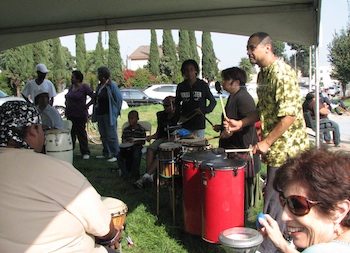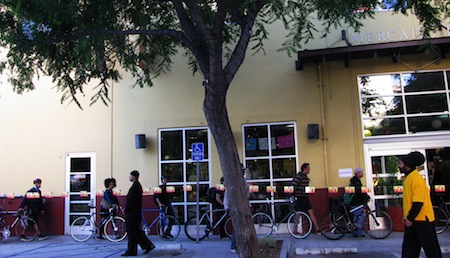 In the shady gated courtyard in front of Mercado La Paloma on Grand Avenue, handfuls of low-rider and fixed-gear bicycles plus a booming DJ sound system set the stage for the “Free the Streets” bicycle and community activism event last Saturday, November 5th.
In the shady gated courtyard in front of Mercado La Paloma on Grand Avenue, handfuls of low-rider and fixed-gear bicycles plus a booming DJ sound system set the stage for the “Free the Streets” bicycle and community activism event last Saturday, November 5th.
Despite sparse attendance throughout the afternoon, the event — also known as the Cycle Music Arts Festival —included screen-printing demonstrations, freehand graffiti painting on the Mobile Mural Lab truck, live DJs and a Pabst Blue Ribbon-sponsored bar.
 Half of the $10 admission fee will help campaigns for safer streets in South L.A. that urge for more bike lanes and green areas, better street crossings and narrower roads. The other half will benefit CicLAvia, a semiannual event that blocks off 7.5 miles of downtown streets to cars and gives bicyclists and pedestrians full reign, and their plan extend the route into South L.A.
Half of the $10 admission fee will help campaigns for safer streets in South L.A. that urge for more bike lanes and green areas, better street crossings and narrower roads. The other half will benefit CicLAvia, a semiannual event that blocks off 7.5 miles of downtown streets to cars and gives bicyclists and pedestrians full reign, and their plan extend the route into South L.A.
“We want to bring Angelenos together and show them each other, show them the city, and make our streets more alive,” CicLAvia board member Joe Linton said. “After the first CicLAvia, we got calls from people from South L.A. saying, ‘Hey, when are you going to come to South L.A.? We love it!’”
After hearing requests from many community groups to bring CicLAvia further south, Linton said he recognized the need for it in the neighborhood.
“There’s a lot of risk of obesity, there’s a lack of park space, there’s a lack of places where communities gather,” he said. “We think CicLAvia can play a role in that.”
 Organizers are tentatively planning for the new route, for the next ride on April 15, 2012, to shoot south on Central Avenue from Downtown Los Angeles and head west on Martin Luther King Jr. Boulevard to Exposition Park and Leimert Park. In the future, they hope to extend it all the way to Watts Towers. But closing down so many streets to car traffic requires money for the proper permits.
Organizers are tentatively planning for the new route, for the next ride on April 15, 2012, to shoot south on Central Avenue from Downtown Los Angeles and head west on Martin Luther King Jr. Boulevard to Exposition Park and Leimert Park. In the future, they hope to extend it all the way to Watts Towers. But closing down so many streets to car traffic requires money for the proper permits.
With events like “Free the Streets,” organizers and activists hope to raise the funds for the route extension as well as awareness of South L.A. as a vibrant and bikeable destination.
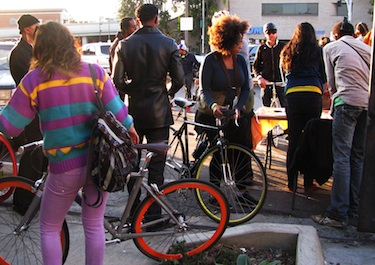 “South L.A. gets a really bad rep from media sometimes,” said Andres Ramirez, a Strategic Actions for a Just Economy tenant organizer. “CicLAvia gets people to explore different parts of the city that they wouldn’t normally explore. That’s what we’re envisioning, bringing it to South Central. South L.A. has a lot of history, has a lot of culture, has a lot of people period.”
“South L.A. gets a really bad rep from media sometimes,” said Andres Ramirez, a Strategic Actions for a Just Economy tenant organizer. “CicLAvia gets people to explore different parts of the city that they wouldn’t normally explore. That’s what we’re envisioning, bringing it to South Central. South L.A. has a lot of history, has a lot of culture, has a lot of people period.”
Ramirez gave Mercado La Paloma as an example: a collective marketplace with gourmet Central and South American restaurants, local artwork on display and a kids’ play area that is a “gem” in the community but largely ignored by the rest of the city.
“Free the Streets” and future CicLAvia routes could introduce more people to independent businesses like the Mercado and an improved view of South L.A.









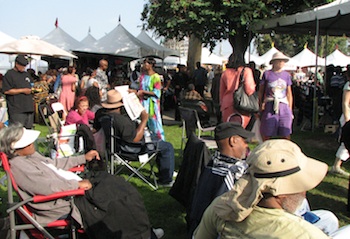

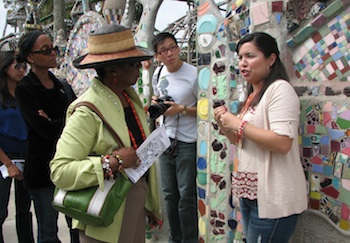
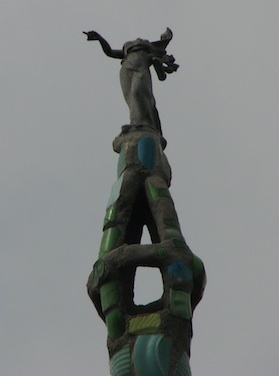
 USC animation graduate student
USC animation graduate student 